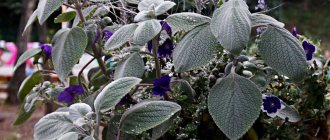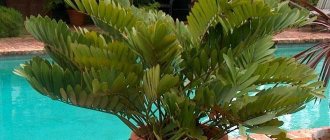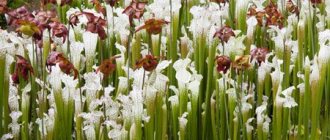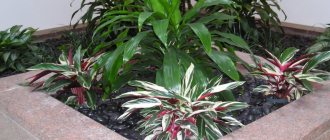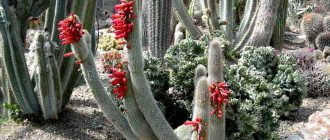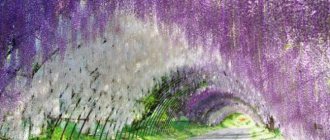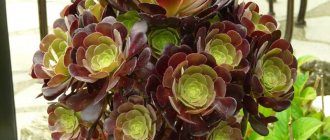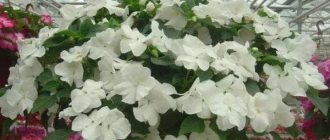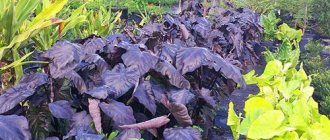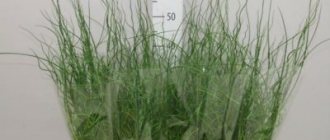Origin and appearance of duranta (photo)
Duranta is a member of the Verbenovaceae plant family. Its homeland is the South American tropics; some varieties (more than 30 of them) grow in the Indian jungle. In natural conditions, durants are shrubs and small trees (no higher than 5 meters).
Brushes of daranta inflorescences are one of the exquisite decorations of the tropical jungle
From a Russian point of view, the name of the plant is not the most beautiful - it is a memory of the Italian scientist Castor Duranta. In Russia, the flower is sometimes called indoor birch (due to the similarity of the leaves) or pigeon berry (possibly due to the bluish color of the flowers). Abroad, duranta is poetically called a heavenly flower and a farewell tear.
The perennial plant duranta is grown as a garden plant in the south, and in northern latitudes it has become an indoor plant. Is it a bush with many branches or a miniature tree, it depends on the formation. Over time, the shoots become covered with light bark and acquire a tetrahedral shape, and the young ones droop, forming something like an arch. Some varieties have not very sharp thorns on their branches. Duranta leaves are small (5–7 cm), harsh, jagged along the edges, like those of a birch, shiny, bright green or with white and yellow markings in variegated forms. Variegated plants are very original.
Durants with variegated leaves are difficult to get to bloom, but they are gorgeous without it
But the most beautiful thing about duranta is the clusters of inflorescences. At the end of young drooping shoots, whole clusters of bluish, lilac, blue, purple, white or two-color buds appear. Duranta flowers are medium-sized, with five petals, and their shape vaguely resembles violas (pansies). Clusters of flowers in dark shades with a white border are especially good.
Each duranta flower is simple, but collected in a brush they are very picturesque
Some varieties are fragrant. Their smell is compared to the aroma of vanilla or irises. They usually bloom from late spring to autumn. With good care, duranta can bloom for six months or longer. If the plant is pollinated, bright orange clusters of round, cherry-like fruits will appear.
The pleasant aroma of duranta flowers attracts butterflies, and after pollination yellow “cherry” fruits are formed.
You have to be careful with the beautiful fool. Its bright fruits and other parts of the plant contain poison. Therefore, when keeping a flower at home, take care of the safety of small children and pets. Place the plant out of their reach. When working with duranta, wear gloves and wash your hands well afterwards.
Duranta is not demanding in terms of home conditions and care. Like most of her tropical compatriots, she prefers bright light, moderate heat and high humidity. These wishes are easily fulfilled, especially if there are other plants at home with the same habits.
Durante needs plenty of room to grow
The duranta bush will be an excellent component of a flower arrangement. But it looks even better as a single plant. An adult specimen can reach a height of one and a half to two meters. During the spring and summer, duranta produces abundant growth. Therefore, its spreading branches need a lot of space for development. You can grow a standard tree.
You can form a bush from duranta, or you can leave one stem and grow a standard tree
And miniature varieties grow as ampelous ones, and sometimes they are used to form bonsai.
Duranta is a very flexible plant that makes charming bonsai trees.
Plumier, variegated, Lorenz and others
In duranta, flower growers are attracted not only by the beauty of the flower clusters, but also by the leaves. Along with flowering varieties with a green crown, variegated ones are cultivated at home: golden or white-green. According to some classifications, duranta is even classified as decorative-leaved indoor plants. Fans note that it is much more difficult to achieve flowering from the variegated duranta. Let's get acquainted with the most common types and varieties.
- Duranta plumier (erect) is most often grown indoors. But there are garden varieties. This is a tree or bush 1.5–2 meters in height when grown at home, up to 5 m in the wild. The stems and woody branches are tetrahedral. The leaves are oval from 5 to 10 cm with a pointed end and uneven teeth along the edges. Small flowers, pale blue or lilac, collected in brushes. Flowering is abundant and long lasting. Afterwards fruits are formed, like yellow cherries. Variegated hybrid varieties have been bred based on Duranta plumier. They are often grown not for flowering, but for their decorative foliage.
- Duranta variegata is a hybrid with white-cream-green leaves and bluish flowers.
- Green and Gold or tricolor, this variety has variegated leaves that are yellow in the center and pale green at the edges. The flowers are blue in color, smell very good and are collected in beautiful clusters at the ends of the shoots.
- Cuban Gold (Cuban Gold) is a hybrid with ellipsoid leaves, they are green-yellow with a reddish-orange sheen, like gold.
- Gold Edge (Golden Edge) is a plant with oval serrated leaves, their middle is green and the edge is bright yellow.
- Lemon Drop (Lemon Drop), this variety has a lemon-yellow leaf center and bright green edges.
- Duranta Sweet Memory is a hybrid with green leaves, blue-violet flowers and a white corrugated border. Chocolate-candy aroma.
- Alba margarita is a variety of plumier that has white flowers.
- Duranta Lorenza is a shrub that grows up to one and a half meters. The shoots are tetrahedral. The leaves are denser than those of plumiers, oval-pointed with dissected edges. Blooms readily if well maintained. The flowers are often white and small. The berries are orange. Hybrid varieties based on Duranta Lorenz are grown indoors.
- Geisha Girl (Little Geisha) - a hybrid with beautiful flowers. They have rich purple petals, white centers and wavy edges.
- White Cayenne Vanilla Bush is a variety with snow-white buds with a strong vanilla aroma.
Types and varieties of flowers in the photo: blue, white, dark blue and others
Gold Edge (Golden edge), the middle of the leaf is green and the edge is bright yellow
Geisha Girl (Little geisha) – a hybrid with purple flowers
Green and Gold (tricolor), variegated leaves in the center are yellow, and the edges are pale green
Lemon Drop, lemon yellow leaf center and bright green edges
White Cayenne Vanilla Bush - snow-white inflorescences with a strong vanilla aroma
Alba margarita is a variety of plumier with white flowers.
Duranta variegata with white-cream-green leaves
Cuban Gold (Cuban gold) - a hybrid with golden yellow leaves
Duranta Lorenz has stiffer leaves
Duranta plumier is often grown indoors
Duranta Sweet Memory - a hybrid with green leaves and blue-violet flowers with a white border
Video: duranta flowering and fruits
Conditions for duranta (table)
| Season | Lighting | Humidity | Temperature |
| Spring | Bright, a little direct sun will be helpful. This is especially important for variegated forms; when there is a lack of light, they turn green. The south-west and south-east are suitable for placement of durantas; on the south side on sunny days the plant should be slightly shaded. In the north, in partial shade it will grow, but is unlikely to bloom. | Slightly increased, 60–70%.
Do not allow water to get on the buds and flowers, they may die. | Moderate, about 20–23 degrees. Duranta does not like drafts and sudden changes in temperature; do not place the plant near an open window. |
| Summer | In the summer, a pot of duranta can be sent for a walk - in the garden or on the balcony. Fresh air enhances flowering. But protect the flower from wind and hot sun. Too intense light can cause foliage to darken. | Moderate, better up to 25 degrees. Protect from heat. With a strong increase in temperature, it can shed its leaves. | |
| Autumn | Lighting: Bright light with a few hours of direct sun. When daylight hours are shortened, provide artificial lighting with phytolamps. | Moderate or increased. The warmer the room, the higher the humidity should be. Do not place the plant near heating devices. Spray if necessary. | Moderate, about 20–23 degrees. Gradually lower the temperature. |
| Winter | Cool, optimally +16–18 degrees. Do not place the plant near heating devices. Below 12 is unacceptable, it can shed leaves. Cool wintering is useful for setting buds. At higher temperatures and lack of light, shoots may stretch and weaken. Protect from drafts. |
About cleanliness and humidity
For duranta, as for all deciduous plants, clean foliage is important. But its leaves are quite small, and wiping each of them is long and tedious. Leaf care can be simplified by giving the flower a shower from time to time. Wash it under a gentle stream of slightly warm (up to 30 degrees) water, after covering the soil in the pot with polyethylene. This procedure will not only help to clean the plant, but will also moisturize the plant and also destroy insect pests.
An infusion of onion peels will give duranta leaves a glossy shine. Fill the jar halfway with onion peels, compact it and fill it with boiling water to the top. Let the liquid sit for a day or two. Strain the infusion and spray the duranta leaves. By the way, this will also be a good prevention of spider mite attacks.
Cleanliness of the leaves is important for the health of the plant; wipe and wash them regularly
Duranta is from the tropics, but has a negative attitude towards heat. In hot weather, it may lose some of its foliage. You can help it by increasing air humidity.
Video: how to increase air humidity in the heat
Lighting
Like most tropical plants, duranta needs plenty of light. But the lighting should be diffused. From direct sunlight it is necessary to create shading. Sunlight is acceptable for short periods of time in the morning or evening.
In winter, the lighting intensity is not reduced; the duration of daylight hours should be up to 10-12 hours a day. If necessary, use additional lighting.
With a lack of light, the plant quickly loses its decorative effect, and flowering may not be expected.
In the summer, in warm weather, the plant can be taken out into the fresh air, protected from drafts and wind.
Planting and transplanting
Young durants are replanted in the spring every year. Adults - approximately once every 3-4 years. Very large plants do not need to be replanted, but limit themselves to updating the top layer of soil (by 4–5 cm).
It is difficult to replant a mature duranta, so only change the top layer of soil
It is advisable to transplant Duranta from the store immediately. Store plants exist in a depleted substrate. And for development they need more nutritious soil. But if you get a blooming duranta, wait until the end of flowering. The stress of transplantation can cause the death of flower buds.
The rule for choosing a pot for planting flowering plants is also true for duranta. If you want vigorous flowering, do not plant it in an overly large pot. In a spacious container, the durant will begin to grow roots and greenery, and flowering will be delayed for at least a year. But if you have a duranta with decorative foliage, and you plan to grow a tree with a lush, variegated crown, but don’t want to bloom, you can take a larger planting container.
Prepare the soil for planting durante that is loose, well-conducting moisture and air, nutritious and neutral in acidity. Approximate compositions:
- ready-made soil for flowering plants (for example, hibiscus), add a little sand;
- universal soil mixed in half with garden soil and the addition of chopped moss;
- soil for indoor plants, turf and humus soil, for looseness - charcoal crumbs;
- 2 shares - rotted compost (humus), 1 share each - leaf soil, sand (vermiculite);
- 2 parts each - turf and leaf soil, 1 part each - peat and sand.
High-quality drainage is very important for duranta. Its layer occupies at least a quarter of the volume of the pot. Expanded clay, brick or natural ceramic chips, vermiculite, perlite, crushed polystyrene foam are suitable.
How to transplant duranta
- Sterilize all components for repotting, including the pot.
- Place a drainage layer and some soil substrate at the bottom.
- Remove the duranta with the earthen lump from the old container. Shake off the soil a little, do not remove it completely.
- Examine the root system; if rotten roots are found, remove them. Healthy roots do not need to be touched.
- Place the earthen ball with the plant in a new pot, carefully add soil between it and the wall, shaking slightly.
- Compact the top layer of soil slightly. If the ground settles, add more. For tall specimens that will not be replanted frequently, do not fill the pot to the brim. This will make it more convenient to change the top layer.
- Water and spray the duranta after transplanting.
- Place the plant in a slightly shaded area.
- After the duranta adapts to the new pot, move it to its original place.
Home care
Duranta is famous as an unpretentious and responsive plant. She quickly responds to care and forgives some mistakes. There is, however, a problem that not all flower growers can cope with. For some, duranta blooms vigorously and for a long time with lush tassels, while others cannot achieve a single flower. Let's try to solve the riddle of duranta. Let's find out how to care for the plant to achieve flowering.
Watering and fertilizing
When discussing the care of duranta, flower growers admit that this plant prefers generous watering in spring and summer. Sometimes 2-3 times a week. Without this, you will not see any flowering or bright leaves. Duranta does not like the soil in the pot to dry out. Although it can be patient: during a forced drought, it will hang its leaves, and after a watering place it will spread out again. But not all will come to life, some will fall. Overmoistening of the soil and stagnation of moisture at the roots of durante are also harmful. Especially in combination with cool air. So in the fall, the interval between waterings is gradually increased, and the amount of water is reduced. In winter, limit it to a minimum, but not allowing complete dryness.
Duranta does not tolerate the soil drying out; if there is a lack of moisture, it can hang leaves
Water for tropical duranta should be lukewarm and clean, without salt impurities. Soft rain or melt water is ideal, but filtered or settled water will do.
Flower growers advise using peat to soften water. Take a piece of about 100 grams, wrap it in gauze and immerse it in a container of water (about 2 liters). After a day, take out the peat, the water for irrigation is ready.
During the period of development and flowering, duranta accepts feeding well. It is applied once every 1–2 weeks. You need to choose fertilizer depending on the plant variety. Varieties with variegated foliage require fertilizing with a high nitrogen content. These are complexes for decorative leaf plants. For duranta to flourish, it will require food for beautifully flowering plants; it contains more phosphorus. Make the concentration of the nutrient solution slightly weaker than recommended by the instructions.
Some gardeners recommend feeding the growing duranta with organic matter, for example, rotted manure. It is added to the soil. It is necessary to carefully select the surface layer of soil closer to the pots. Place several spoons of rotted manure on different sides of the earthen clod; it should not touch the roots. After fertilizing, add the selected soil and water the plant.
Video: how to properly water indoor plants
Flowering problems
Duranta is still terra incognita for most gardeners. Not everyone has adapted to the habits and desires of this plant. And the most important problem is the lack of flowering. Some duranta owners are sincerely surprised when they learn that duranta is a thriving crop. For variegated varieties this is almost normal. Beautiful-leaved durants bloom rarely and sparingly. Perhaps because they are fed nitrogen or there is simply not enough strength for both leaves and flowers. But green durants can and should bloom. The life of each flower lasts about 10 days. And shoots with buds of duranta are thrown out for almost six months with short pauses. And judging by the stories of flower growers, this is not so difficult to achieve.
Experienced flower growers assure that it is not at all difficult to achieve duranta flowering.
The happy owner of a lushly blooming duranta says that the plant on the south window bloomed even in winter. And in the summer, when the pot was moved to the sun in the garden, flowering began again. The faded brushes were cut off, but new ones appeared. At this time, the plant was fed with fertilizer approximately 5–6 times per season. And after the duranta was removed into partial shade - opposite the eastern window, there were no buds. According to this gardener, the main thing for flowering is sufficient lighting.
The gardener's reward for diligence is the first flower brush
Another successful experience. According to the florist, duranta winters at +15–16 degrees. In summer it is located on the open balcony on the east side. It receives sun from early morning until noon. To save space, the housewife does not grow large plants, but takes cuttings from them in February to get young ones. And he severely prunes the duranta shoots for branching. Since spring, it has been fed once a week with liquid fertilizer for flowering plants. In hot weather, water daily. The result is that young durants are actively blooming. Moreover, clusters of inflorescences form all summer with a short break.
After all the flowers in the brush have faded, it must be trimmed. This will stimulate further flowering.
Let's summarize what to do for successful flowering of duranta.
- Give the plant more light in both winter and summer.
- It is imperative to carry out anti-aging pruning after winter before growth begins. Flower clusters are formed at the ends of young shoots.
- Provide cool rest in winter.
- Feed the duranta with fertilizer for flowering plants.
- Grow the flower in a cramped pot to encourage the appearance of buds.
Bright light, a dark pot, pruning and nutrition - all you need for duranta to bloom
Trimming
As we have already found out, without anti-aging pruning, duranta will not bloom. And a bush with decorative foliage without shaping will look sloppy. Duranta, especially in favorable conditions, grows very rapidly.
In the spring, the gardener needs to arm himself with pruning shears (mature duranta branches are covered with bark, which scissors may not be able to cut) and start cutting. Remove thin, weak or diseased shoots, shorten healthy ones if necessary. Shape the crown to your liking. You can grow a standard tree, hanging plant, branched bush or bonsai. Duranta is a good material for realizing the ideas of a florist. She easily and naturally endures the pruning procedure.
Duranta responds very well to pruning; you can shape anything from this plant
In summer, drooping shoots must be pinched at 2-3 internodes so that lateral buds develop, and wilted clusters must be removed. And in the fall, after flowering has completed, sanitary pruning will be useful. Cut out broken and weak shoots, those that thicken the crown, or aged bald branches.
How to care during the dormant period
If you give the duranta a lot of light, keep it warm and water it enough, it can bloom even in winter. But year-round flowering will sooner or later deplete the plant’s strength.
If you provide duranta with artificial additional lighting and warm conditions in winter, it will bloom, but will deplete its strength.
Still, he needs to ensure peace. Lower the temperature, at least to +18, reduce watering, cancel fertilizing. But leave the light, even add artificial light. Duranta winters better with good lighting. Don't be alarmed if your plant loses its leaves in the fall and winter. For duranta, especially green ones, this is normal. The crown can thin by about a third during rest. And then, in the spring, it will grow again.
Duranta feels good with artificial increases in daylight hours. Most of all, variegated varieties need light. But ordinary incandescent lamps are not suitable for illumination. You need special phytolamps, gas-discharge or fluorescent lamps. LED lamps provide the most effective illumination.
Before waking up, don’t forget to radically cut your beauty’s hair.
Care errors (table)
| Error manifestation | Cause | Elimination |
| Duranta began to fall leaves. | Natural phenomenon in autumn and winter. Excess sun, dry air and heat. | In the summer heat, moisten the plant more often and do not allow the soil to dry out. Provide shade from the sun on hot afternoons. |
| The branches are too elongated, the leaves are faded. | Lack of light. Not enough nutrients. | Place the duranta in a brighter place or use artificial lighting. Fertilize the plant during its growth period. |
| The tips of the leaves dry out and the shoots wither. | Not enough watering. | Adjust the frequency and amount of watering. The soil should always be slightly moist. |
| Duranta does not want to bloom. | For variegated forms, lack of flowering is a common difficulty. Green durants bloom from late spring to autumn. Perhaps you do not comply with the conditions of detention and care rules. | Flowering formula: more light + pruning before growth begins + cool winter + fertilizer for flowering plants + tight pot. |
| Duranta leaves darken, acquiring a bronze tint. | Too intense sun. | There is nothing wrong with this phenomenon. This is a reaction to abundant light. Shade the plant. |
Features of cultivation
Temperature
Loves warmth. In winter, moderate temperatures are recommended. The temperature should not be allowed to be less than 16 degrees. If it is too warm, a scale insect may settle. The room should be regularly ventilated, but the plant should be protected from cold drafts.
Illumination
You need bright, but diffused light. It is recommended to choose windows with western or eastern orientation for placement. In the summer, it is best to take it outside, but you should gradually accustom it to direct sunlight.
How to water
In the spring-summer period, watering is plentiful, and in winter it is reduced to moderate. The substrate in the pot should always be slightly moistened.
Top dressing
The plant must be fed in spring and summer. To do this, use liquid complex fertilizer for indoor plants.
For fertilizing, you can also use organic fertilizers, for example, rotted cow manure. Feeding is carried out in a special way. To do this, carefully remove the top fifteen-centimeter layer of soil, and then pour several large spoons of fertilizer into the pot. Try to distribute it on all sides next to the walls of the container. After this, the removed soil layer is returned to the pot.
Humidity
High humidity is required. Systematic spraying is recommended. In winter, duranta should be placed away from heating devices. If the humidity is too low, a scale insect or spider mite may settle on the plant.
Features of transplantation
Young specimens are replanted once a year. Large plants are subjected to this procedure once every 2 years. A suitable soil mixture consists of leaf, turf and peat soil, humus, and sand, taken in a ratio of 2:1:1:1:1.
Reproduction methods and care
This plant is quite shade-tolerant, but flowering may not occur in a shaded place. East or west windows are suitable for placement. Requires shading from direct sunlight. Species with variegated leaves should be placed in a well-lit place. Moderate watering is needed all year round. Spraying is carried out in extreme heat and for this purpose soft water at room temperature is used. When moistening the foliage, make sure that the liquid does not get on the flowers.
For planting, you can use a soil mixture consisting of leaf and turf soil, sand, and also peat, taken in a ratio of 2:2:1:1. Good drainage is necessary because the plant does not tolerate stagnation of liquid in the soil. Adult specimens should be replanted in the spring no more than once every 2 or 3 years. You can simply change the top layer of the substrate once a year.
This plant tolerates cold well and does not grow and develop well in heat. So, in summer it is recommended to keep the room cool (from 15 to 18 degrees), in winter it should be from 13 to 15 degrees. If the duranta is in the heat, it will begin to wither. Fertilize only during the period of intensive growth; for this purpose, liquid complex flower fertilizer is used.
Can be propagated by cuttings. They are pruned in spring and rooted in loose soil rich in nutrients. To make the cuttings sprout roots faster, you can add a little growth stimulating substance to the water for irrigation.
Pests and diseases
- Scale - brownish plaques appear on shoots and leaves. Pests feed on plant sap. Flowers and foliage turn pale, dry out and die completely. To destroy scale insects, you first need to wash the plant with a sponge moistened in a soapy solution. After this, it is treated with a 0.15 percent Actellik solution (take 1 liter of water for 1 or 2 milligrams of the drug).
- Spider mites - settle when the humidity is too low. You can find cobwebs in the internodes on the shoots; the leaves wither and die. To destroy pests, wash the plant with soapy water using a sponge, and then give it a warm shower. It is necessary to systematically spray the duranta in the future. If there are a lot of spider mites, then you can treat the plant with a 0.15 percent Actellik solution (1 or 2 milligrams per 1 liter of water).
- Aphids can also settle on this tree. It can be found on the underside of leaves, as well as on young shoots. The leaves lose color, curl and die. To destroy the duranta, it is necessary to treat the duranta with fitoverm, actellik, derris, decis or inta-vir. If necessary, treat again after a few days.
Diseases and pests
Duranta is in fairly good health. But with improper care, for example, excessive watering in a cold room, the roots may begin to rot. And too dry air provokes the proliferation of parasitic insects. If there are not many attackers, use folk remedies - spraying with infusions of wormwood, tobacco, onion or garlic. But massive attacks will have to be fought off with chemicals. As a preventive measure, regularly inspect the duranta. At the first signs of damage, take measures to prevent pests from multiplying.
Who or what is harming the duranta? (table)
| Disease or pest | Manifestation | Control measures |
| Aphid | Young leaves and shoots fade, curl, and dry out. Insects are clearly visible; they settle in colonies on the underside. | Remove dead parts of the plant. Wash the duranta in the shower. Spray with insecticide (Derris, Fitoverm). |
| Shchitovka | Brownish, hard plaques on the leaves; parasites feed on the sap. The foliage is dying. | Destroy parasites by hand by wiping them off with a soapy sponge. Treat duranta with Actellik solution (1-2 ml of the drug per liter of water). |
| Whitefly | The leaves turn yellow and die. There are greenish larvae on the underside of the leaf; they feed on the sap of the plant. | Fighting whiteflies is not easy. Once every three days, spray the plant with preparations containing permethrin, Admiral or Kinmiks insecticides. The pest dies only after repeated treatment. |
| Spider mite | The leaves wither and fall off. There is a noticeable cobweb on the stems. | Arrange a shower for the duranta. Then spray with insecticide (decis, inta-vir). For prevention, regularly moisten the air and the plant itself; mites reproduce only in dry conditions. |
| Root rot | The leaves are withering, but the soil is moist. | Dry the soil, adjust the watering regime. If this does not help, remove the plant from the pot, remove the rotten roots, sprinkle the cuts with charcoal and root formers, then replant them in a new sterilized substrate. |
Humidity
Durante requires high air humidity. When the air is dry, the leaves die and curl. Regular spraying . In summer, it is good to give the plant a warm shower.
Maintaining air humidity is also a good prevention against pests.
In winter, they also maintain high air humidity, while monitoring the condition of the soil.
Duranta (Duranta erecta)
Reproduction
New durants can be grown from cuttings and seeds. When cuttings, the variegated color of the leaves is not always preserved. Therefore, variegated varieties are better obtained by seed propagation.
Cuttings
The most suitable time for propagation by cuttings is autumn, when the duranta has already bloomed. Its branches are still full of vitality and can be easily rooted. But you can do cuttings in the spring.
- Using a sharp and clean knife, cut the cuttings - the tops of semi-lignified shoots.
- Dip the cuttings into the growth stimulator solution for a few seconds.
- Prepare the substrate for rooting: equal parts peat and sand or perlite. Sterilize it.
- Pour the substrate into the greenhouse. Ideally, it should be with bottom heating.
- Plant the cuttings in a moistened substrate, spray with warm water and cover with a lid or transparent, moisture-proof material.
- Place in a warm (25 degrees) and bright place, but without direct sun.
- Moisten and ventilate the plantings.
- After about 3-4 weeks, the cuttings should take root.
- After new leaves appear, transplant the seedlings into separate containers.
- Young durants grown from cuttings will bloom in the second year.
Cuttings are the simplest and most effective way to propagate duranta.
